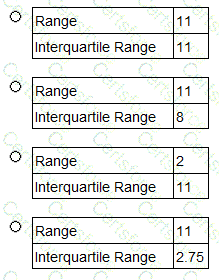A discrete random variable can only take the values 2,3,4 or 5. The probabilities associated with some of the outcomes are: P(X=2) = 0.2, P(X=3) = 0.3, P(X=5) = 0.1.
For a randomly drawn value of X, calculate P(X>3).

Assuming the position of the first quartile of an appropriately ordered dataset is given by

and the position of the third quartile of an appropriately ordered dataset is given by

Calculate the range and interquartile range of the above dataset.

A geometric series is given by

Identify the values of x for which the series converges.
The probability density function f(x) for a random variable X is defined over the interval 0 to 1.
f(x) = 2(1-x).
Calculate the probability that X is greater than 0.5.
When differentiating the product of two factors, u and v, the Product Rule can be used.
State the Product Rule.
A)

B)

C)

D)

Calculate the indefinite integral:

A)

B)

C)

D)

A weekly pet insurance premium is given by a solution of the following equation:
4x2 - 11x - 3 = 0
Calculate the premium.
Identify the meaning of: | x | > 5
Consider the function f(x) = x2-6x+20. This function has a stationary point at x = 3.
Determine the nature of this stationary point and how do we know this to be true.